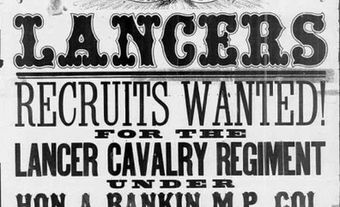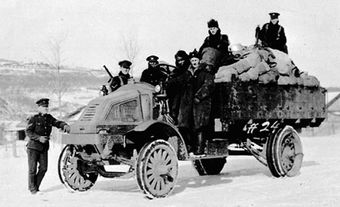Soldiers of Fortune is a term used to describe those ready to serve in a military or police capacity under any state or person outside their own country.

Definition and Examples Abroad
Often confused with mercenaries who are motivated chiefly by gain, monetary or otherwise, soldiers of fortune seek adventure or serve for idealistic reasons and have existed from the earliest times. Christopher Columbus, for example, was a Genoese in the Spanish Navy. In the 19th century, Lord Byron joined the Philhellenes to free Greece from Turkish rule, and “Chinese” Gordon's “Ever-Victorious Army” attracted soldiers of fortune during the Taiping Revolution in China in the 1860s, as has the French Foreign Legion since its inception in 1831. In this century, the Spanish Foreign Legion, the “Flying Tigers” in China, and the International Brigades of the Spanish Civil War have also drawn soldiers of fortune to their banners.
19th-Century
Canadian soldiers of fortune have often been professional soldiers or entrepreneurs who have become adventurers by chance as, for example, Sir William Fenwick Williams of Nova Scotia, commander of a Turkish army in the Crimean War of 1854–56, and Torontonian Alexander Roberts Dunn who won a VC at the Charge of the Light Brigade at Balaclava during the same conflict. Elsewhere, Daniel O'Connor (died 1858) of Ottawa was a volunteer in the Irish Legion against Spanish colonial troops in Panama in the early 1820s, John Richardson fought from 1834 to 1837 in the British Auxiliary Legion during the Carlist Wars in Spain, and Col George Mason Green (1836–1912) and Narcisse Faucher de Saint-Maurice served respectively with Juarez and Emperor Maximilian during the French occupation of Mexico in the 1860s.
Some 45,000 Canadians are estimated to have served in the American Civil War. Several hundred French Canadians joined the Canadian Pontifical Zouaves of the Papal Army to prevent the unification of Italy by the forces of King Victor Emmanuel in 1868–70, while Arthur Buies had served in the forces of Giuseppe Garibaldi that opposed them. Toronto-born Civil War veteran Brig William Ryan, who joined the Cuban revolutionary army, was captured aboard the filibustering vessel Virginius in 1873 and was executed by the Spanish in Cuba. Another Civil War veteran, Lieutenant William Winer Cooke (born 1845) of Mount Pleasant, Ontario was adjutant to Colonel George Armstrong Custer and among the 14 Canadians in the Seventh Cavalry; at least 4 of them died with Custer at the Battle of the Little Bighorn in 1876.
In the North-West Resistance of 1885, Martin Waters Kirwan (1841–99), a veteran of the French Foreign Legion, served as a staff officer under Major-General Frederick Middleton, while William Henry Jackson joined the Métis forces as secretary to Louis Riel.
In the early 1890s, William Grant Stairs seized Katanga (Shaba) for Belgium. Commandante Joseph Chapleau died in action in 1897 in an attack on a Spanish garrison, and nine Canadians served in Teddy Roosevelt's “Rough Riders” in Cuba in the Spanish-American War of 1898, which was reported on by one of Canada's most celebrated early war correspondents, Kathleen (Kit) Coleman. George Charette, of Sainte-Élisabeth, Quebec was a US Navy volunteer during the same conflict, who helped in sinking a barge at the mouth of Santiago harbour. Henry Herbert Stevens was a member of the US Army in the Philippines and later in China during the Boxer Rebellion.
20th-Century
Colonel Charles James Townsend Stewart (1874–1918), of Halifax, killed while commanding the Princess Patricia's Canadian Light Infantry on the Western Front in the First World War, was a soldier of fortune in China and Peru as well as a North-West Mounted Police trooper in the Yukon and a railway foreman in British Columbia.
James Kennedy Cornwall served in a Venezuelan revolution at the turn of the century, and Frederic Franklin Worthington commanded three ships of the Nicaraguan navy against one Salvadorian ship of Frederick William Thompson (1888–1985) in a 1906 boundary war; both men later served in the Borden Machine Gun Battery on the Western Front. Aloha Wanderwell Baker was a soldier-pilot-photojournalist who served in the French Foreign Legion against the Riffs, and was an adviser to a Chinese army during the Warlord Era of the 1920s, while Morris Abraham Cohen helped train Chinese troops during the same period.
Leon Bedat (1881–1961) of Huntsville, ON and Jan Van den Berg (1884–1961) were among several dozen Canadian volunteers in the Mexican revolutions of 1911–20; later, both men served on the Western Front in the First World War and in southern Russia (see Canadian Intervention in Russian Civil War). Raymond Collishaw, Joseph Whiteside (“Klondike Joe”) Boyle, John Edwards Leckie and Walter Sussan (1892–1969) of Ottawa participated in the Russian Civil War.
In 1920, T.V. McCallum of Toronto was killed while a member of the Kosciusko Squadron in Poland flying against the Bolsheviks. Hilliard Lyle (1878–1931) of Allenford, ON served with the Greek Army against Turkey in 1920–22, while Sussan flew as a fighter-pilot with Greece's Air Force; in 1925, Sussan joined the Escadrille de la Garde chérifienne in Morocco and flew bombers against the Riffian rebels of Abdel Krim on behalf of the French. In the mid-1920s, Bert Levy (1897–1965) of Hamilton, ON and Alfred Batson (1900–77) of Vancouver were gunnery officers under Augusto Sandino in Nicaragua, while Ralph Beardsley (1899–1982) and Ted Huestis (1909–61) fought for the government alongside the US Marines and the Guardia Nacional. Huestis was an adviser to the Chinese Army and a pilot in the Ecuadorian Air Force, and Levy the first Canadian to join the International Brigades (British Battalion) in the Spanish Civil War (1936–39). (See also Foreign Enlistment Act.)
Toronto labour journalist and playwright Edward Cecil-Smith, a former adventurer in South America, commanded the Mackenzie-Papineau Battalion in Spain. In the same conflict, Norman Bethune ran the celebrated Canadian blood-transfusion service for the Spanish Army. Members of his staff were Hazen Sise and Ted Allan of Montreal, Henning Sorensen of Vancouver and Allen R. May of Toronto. Ralph Linton of London, ON who had fought the Japanese in a Chinese guerrilla army, also served in Spain, as did writers Alain Grandbois and Hugh Garner. BC adventurer and journalist Sir Michael Bruce (1894–1957) led two Brazilian rebellions.
Fighter ace George Frederick "Buzz" Beurling died in the crash of a plane that he was ferrying to Palestine during Israel's War of Independence in 1948. That same year, Sherman "Snark" Wilson, former chief pilot for BWIA, was shot down during a Salvadoran revolution. In Israel, Second World War Royal Canadian Air Force (RCAF) veteran Clifford Denzel (Denny) Wilson of Hamilton shot down two Egyptian Spitfires, while Joseph John Doyle and John McElroy of London downed three and four Arab aircraft, respectively, while Flying Officer Leonard Fitchett was killed during a bomber attack on an Egyptian-held fortress. Several hundred other Canadians volunteered for service in the Israeli forces, among them Ben Dunkelman, Lee Sinclair, Morris Pearce and John (Jack) Blanc of Toronto.
RCAF flier, writer and Korean War veteran Tony Foster (born in 1932) participated in the overthrow of Arbenz of Guatemala in 1954 and of Villeda Morales of Honduras in 1957. Canadians have served in the Congo, Biafra, Rhodesia and Angola as well as in other African and Latin American conflicts of the 1960s and 1970s. As many as 35,000 of them served alongside British, Irish, German, Korean and other foreign volunteers in the US forces during the Vietnam War. Richard Dextraze, son of General Jacques Dextraze, Canadian Army (Ret) was among the 56 Canadians listed as killed or missing in action in that conflict. Toronto adventurer and freelance writer Peter Bertie was killed in action in Nicaragua in March 1987, while working with anti-Communist “Contra” guerrillas.

 Share on Facebook
Share on Facebook Share on X
Share on X Share by Email
Share by Email Share on Google Classroom
Share on Google Classroom



